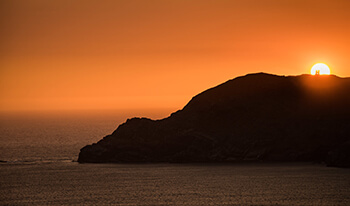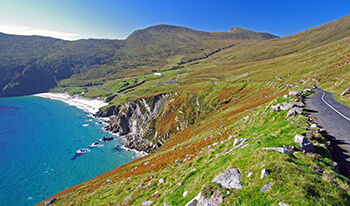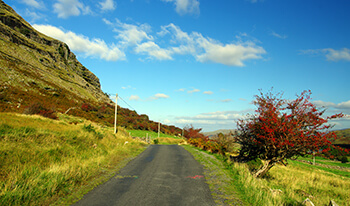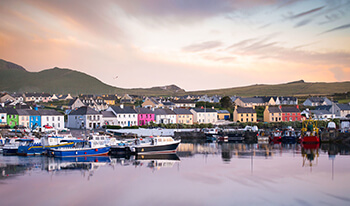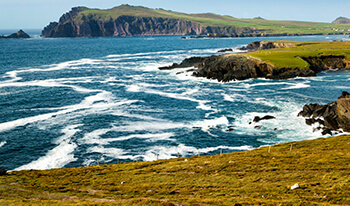This Best of Ireland Tour, our most popular tour, can be accessed using any of the Irish Airports and is a 12 night driving tour based on Ireland’s most famous sights
Attractions include Trinity College and Kilmainham Gaol in Dublin, Powerscourt House & the Waterford Crystal exhibition in the South East, Blarney Castle and the Cobh Heritage Centre in Cork, Killarney and the Dingle Peninsula in County Kerry, the Cliffs of Moher and the ‘Burren Landscape’ of County Clare as well as the Aran Islands and Connemara in County Galway and Ireland's most visited attraction, the ancient Megalithic Tombs at Newgrange, just 45 minutes north of Dublin.
Depending on the airports used, the stopovers outlined below may vary in order but the same route will be covered.
This tour will leave the traveller with a wonderful array of memories of the diverse scenery and cultural differences that they will encounter from one side of the country to the other. While the accents and dialects of the spoken word will vary greatly while journeying from County Dublin in the East of Ireland to the western counties of Cork, Kerry and Clare, the one unchanging constant will be the level of friendliness, humour & welcome that you receive throughout your travels.
While the suggested tour itinerary clearly outlines how you will be able to visit many of Ireland’s most historical locations and attractions, make sure to take time-out to get to know the local people and their culture.
What's included
Tour Highlights
See ItineraryOvernights for this tour
Accommodation Options
Rest easy - handpicked stays for your style and budget

Deluxe Accommodation in our 4 & 5 Star Irish Castles

Luxury Accommodation & Service in our 4 & 5 Star Hotels

Mid Range 3*** Hotels

Our Recommended & Handpicked B&B's

Superior 4**** Hotels
Tour itinerary
Day 1 - Dublin to County Wicklow

Upon collection of your rental car, you will be traveling south through County Wicklow, also known as the ‘Garden of Ireland’. First stop will be Powerscourt House & Gardens. Surrounding this 18th Century Palladian House in the foothills of the Wicklow Mountains, you will find a sublime blend of formal gardens, sweeping terraces, statuary and ornamental lakes together with secret hollows, rambling walks and over 200 varieties of trees and shrubs. Shortly after this, you will arrive at the ancient monastic settlement at Glendalough. Glendalough “the glen of the two lakes” is a truly spellbinding place - an ancient monastic settlement and two clear water lakes beneath the sheer cliffs of a deep valley, which was carved out by glaciers during the Ice Age. The monastic settlement has been a centre for pilgrims and visitors since its foundation by St. Kevin in the 6th century. From here, follow the signs for Avondale House. Built in 1779 Avondale House is set in the spectacular surroundings of Avondale Forest Park, now a museum to the memory of one of the greatest political leaders of modern Irish history, Charles Stewart Parnell, who was born in Avondale on 27th June, 1846. Continue on to Avoca where you will find the Avoca Handweavers factory, famed worldwide for the quality of its woven fabrics. As well as visiting its shop, you will be able to take a tour of the factory in this most picturesque of villages. The village was also the setting for the top television series “Ballykissangel”.
Day 2 - Wicklow to Kilkenny & St. Canice's Cathedral

Today, you will be heading south to County Wexford and then northwest to Kilkenny. Stops along the route include the town of Enniscorthy which is an old Norman settlement and is situated on the banks of the River Slaney and is overlooked by the old 1798 battle site of Vinegar Hill. Dominating the town is the Norman Castle which was completed in 1205 and now houses the County Wexford Folk Museum. You may then visit the South Eastern corner of Ireland to visit the ancestral home of the Kennedy’s at the Kennedy Homestead as well as visiting the Dunbrody Famine Ship. An interactive exhibition re-enacts life on the Dunbrody as she carried her passengers from New Ross to the US and Canada 150 years ago. From here, pay a visit to the new interpretive centre for Waterford Crystal that has been opened (July 2010) since the closure of the famed Crystal Factory. On to Kilkenny - Long renowned as Ireland’s Medieval Capital, the city’s origins date back more than 1,500 years. Characterized by beautifully restored old buildings, Kilkenny City is small and compact enough to explore on foot, yet full of fascinating, historical buildings. Kilkenny Castle is a 12th century castle remodelled in Victorian times and set in extensive parklands. Also in Kilkenny is Saint Canice's Cathedral, the second longest of Ireland's medieval cathedrals. Built on the site of an earlier church, the major portion of the work that produced the beautiful Gothic structure was carried out in the middle of the 13th Century.
Day 3 - Kilkenny and Rock of Cashel

Today, you will be heading south to County Wexford and then northwest to Kilkenny. Stops along the route include the town of Enniscorthy which is an old Norman settlement and is situated on the banks of the River Slaney and is overlooked by the old 1798 battle site of Vinegar Hill. Dominating the town is the Norman Castle which was completed in 1205 and now houses the County Wexford Folk Museum. You may then visit the South Eastern corner of Ireland to visit the ancestral home of the Kennedy’s at the Kennedy Homestead as well as visiting the Dunbrody Famine Ship. An interactive exhibition re-enacts life on the Dunbrody as she carried her passengers from New Ross to the US and Canada 150 years ago. From here, pay a visit to the new interpretive centre for Waterford Crystal that has been opened (July 2010) since the closure of the famed Crystal Factory. On to Kilkenny - Long renowned as Ireland’s Medieval Capital, the city’s origins date back more than 1,500 years. Characterized by beautifully restored old buildings, Kilkenny City is small and compact enough to explore on foot, yet full of fascinating, historical buildings. Kilkenny Castle is a 12th century castle remodelled in Victorian times and set in extensive parklands. Also in Kilkenny is Saint Canice's Cathedral, the second longest of Ireland's medieval cathedrals. Built on the site of an earlier church, the major portion of the work that produced the beautiful Gothic structure was carried out in the middle of the 13th Century.
Day 4 - Kilkenny to Kinsale in County Cork

In the vent that you did not visit it yesterday, your first stop today is the Rock of Cashel in County Tipperary. Cashel was once the seat of the Kings of Munster and capital of this southern province. The Rock, which rears above the plain, dominated the land routes southwards. Kings of Ireland as well as Munster came to this spot and St. Patrick is known to have preached on the rock and converted the local King, Aenghus, here in the 5th Century. Just 10 miles further on stop is Cahir Castle, once an important stronghold of the powerful Butler family, which retains its impressive keep, tower and much of its original defensive structure. It is one of Ireland’s largest and best-preserved castles. Just east of Cork City is the harbour town of Cobh. Cobh, situated on one of the world’s largest natural harbours, was the last port of call for the ill-fated Titanic in 1912 and was the closest port to the site of the sinking of the Lusitania in 1915. The Cobh Heritage Centre sympathetically recounts these events and tells the story of emigration from Ireland to the United States and Australia from the time of the famine in 1847 up to the 1950s – known as the Queenstown Story. From Cobh to Kinsale. As well as being a charming coastal fishing harbour, Kinsale's International Museum of Wine tells the romantic story of the Irish emigrants who colonised the wine trade throughout the world after being forced to leave their own shores. Also in Kinsale is the 17th century Desmond Castle was turned into a prison. The Charles Fort is also close by.
Day 5 - Kinsale and the Charles Fort

If you did not have a chance to visit the following of Kinsale's major attractions, make sure to include them today. Desmond Castle and the International Museum of Wine, which was built in about 1500 had many uses. In 1600 and 1601 it was used as an arsenal by Don Juan Aguilla during the Spanish occupation of the town which lasted for 100 days prior to the Battle of Kinsale in 1601. In the 17th century the castle became popularly known as the "French prison" and was used for prisoners of war, most of whom were captured at sea.During the American war of Independence, the crews of many American vessels were held prisoner in Kinsale in poor conditions. Other notable attractions include Charles Fort, the 17th Century star-shaped fort. St. Multose Church is well worth a visit and was built in 1190. The Courthouse and Regional Museum in was used for ceremonial occasions in the 18th century. In 1915, the Courthouse was used for the inquest into the sinking of the Lusitania. The Regional Museum is now housed in the Courthouse.
Day 6 - Kinsale to Killarney in County Kerry

Today you have the option of the scenic but longer coastal route or the shorter route via Blarney Castle. The longer route includes visits to Mizen Head, the southernmost point in Ireland, as well as Bantry House And Gardens and the French Armada Centre, also in Bantry. From Bantry, you will be heading north to Killarney via the Healy Pass. Have your camera’s at the ready for some breathtaking scenery across the Caha Mountains that divide Cork from Kerry. After the mountain pass, you come to the town of Kenmare. The town was founded in 1670 by Sir William Petty and has a history of lace making, demonstrations of which can be seen at the town’s Heritage Centre. The alternative route for todays journey is a shorter one. First stop is the famed Blarney Castle where a climb to the ramparts to kiss the Blarney Stone is said to bestowe the gift of eloquence, otherwise known as ‘the Gift of the Gab’. From there it is straight to Killarney. With its three famous lakes and majestic mountain ranges, Killarney has been the inspiration of poets and painters over many centuries. The Killarney National Park is internationally renowned both for its scenic beauty and scientific interest. There are many walks and trails around Killarney including a 2-hour tourist trail around the town itself. You will also have a chance to visit Ross Castle, the Gap Of Dunloe or simply take a stroll through the streets of this quaint town to enjoy the great pubs and enjoy the traditional Irish music on offer.
Day 7 - Killarney, The Ring of Kerry and Muckross House

You have a number of touring options today. Chief amongst these is the Ring of Kerry driving tour. The Ring of Kerry is a journey through some of the country’s most outstanding scenery around the Iveragh Peninsula. Stunning mountain and coastal scenery combined with colourful towns and villages will make this one of the highlights of your tour. For those who wish to take a break from driving we can arrange a bus tour through this route. Following the peninsula drive, you then arrive at Muckross House. Muckross House is a magnificent Victorian mansion completed in 1843 for Henry Arthur Herbert. The location of the House is spectacular, close to the eastern shore of Muckross Lake and set beneath the impressive backdrop of Torc and Mangerton Mountains. As an alternative to the Ring of Kerry tour you may prefer to take a wonderful tour by pony and trap that takes you through the Black Valley in the Gap of Dunloe. After a snack at Lord Brandon’s Cottage, you will return to Killarney by boat via the beautiful lakes of Killarney.
Day 8 - Killarney to the west coast of County Clare

One of your longest but most dramatic days of your tour brings you from Killarney to the west coast of County Clare. First stop will be the Village of Adare in County Limerick. Adare is regarded by many a seasoned traveller as Ireland’s prettiest village with its charming thatched cottages, manicured public park and ancient church. From Adare continue along the N20 towards Limerick City of ‘Angelas Ashes’ fame and home to King Johns Castle. Shortly after this, you arrive at Bunratty Castle. Built in 1425, this majestic castle was restored in 1954 to its former medieval splendour. Within the grounds of the Castle is Bunratty Folk Park where 19th century Irish life is vividly recreated. Continuing on to the magnificent ‘Cliffs of Moher’. The majestic Cliffs of Moher are without doubt one of Ireland’s most spectacular sights and overlook the Atlantic Ocean on the coast of West Clare. You then arrive at the village of Doolin. Doolin is world-famous for its wealth of Irish folk music and in recent years has been attracting crowds to spontaneous sessions in any one of its excellent pubs. Just north of the Cliffs you then have the lunar like Burren region and the ancient Poulnabrone Dolmen Tombs.
Day 9 - West Coast of Clare to Galway

Today we travel to the university city of Galway via the lunar like Burren Region and the ancient Poulnabrone Dolmen Tombs. Also on route, you will have a chance to visit Dunguaire Castle was built in 1520 by the O'Hynes clan on the picturesque shores of Galway Bay. Galway, the ‘City of the Tribes’ is also known as Ireland’s Cultural and festival capital. With its street entertainers and traditional pubs with great music, Galway and in particular, the Quays area of the city centre will enthrall you particularly in the evening time. Other sites in Galway include Ireland’s largest medieval parish church, the Collegiate Church of St Nicholas of Myra dating back to 1320. Christopher Columbus reputedly worshipped in this church in 1477. Also nearby are Galway Cathedral, the Spanish Arch and Eyre Square.
Day 10 - Galway and the Connemara Region

Today, the hauntingly beautiful Connemara Region awaits you. Just west of Galway, Situated on the most western seaboard of Europe, this unspoilt region boasts breathtaking scenery. The characteristic features of Connemara include its rugged, unpolluted coastline, dramatic mountains, numerous lakes and rivers and woodlands and the renowned Connemara National Park. Visit Kylemore Abbey and the Lough Inagh Valley as well as the spectacular Sky Road near the town of Clifden. You can also visit the fishing village of Roundstone and see how a ‘Bodhran’ (traditional Irish Drum) is made. Alternatively, you may prefer to take the ferry to the Aran Islands. Aran will take you back to an Ireland of Celts and Early Christians. Take a pony and trap, or a guided tour from the pier up the island to the stone fort of Dun Aengus. Dún Aengus is located on top of a 300ft high sea cliff andis one of the finest prehistoric monuments in Western Europe. This evening, back to the Quays area of the city for some of the best traditional entertainment in the country.
Day 11 - Galway to Dublin via Clonmacnoise

Todays journey to Dublin takes in some of Ireland’s most historical landmarks. First of these is the ancient monastic settlement at Clonmacnoise. This is an early Christian site founded by Saint Ciaran in the 6th century on the banks of the River Shannon and includes the ruins of a cathedral, eight, two round towers, three high crosses and a large collection of early Christian grave slabs. From here, we travel either to Dublin or take a slight detour to the megalithic tombs of Newgrange. One of the great wonders of the ancient world, Newgrange is older than Stonehenge, Mycenae or even the Pyramids of Egypt and is foremost among the passage-tombs of Europe. From here, we travel south to Dublin City. Dublin city centre is a compact area, with all points of interest being easily accessible on foot. As a result you will find a large number of walking tours available, the most popular of which include the “Historical Walking Tour” and the “Literary Pub Crawl”. You may of course wish to visit many of the sights in your own time either on foot or with the Hop-On-Hop-Off bus service that stops at all of the major attractions including Dublin Castle, Trinity College & the Book of Kells, Kilmainham Gaol, the National Museum of Ireland and The Guinness Storehouse to name just a few.
Day 12 - Dublin city centre and Trinity College

Continue your sightseeing in Dublin today visiting the many historical and modern attractions that this cosmopolitan city has to offer. Other attractions include Christ Church Cathedral which was founded in the year 1030 by Sitric, King of the Dublin Norsemen, the James Joyce Centre & the Dublin Writers Museum. Of course, you may wish to take time out to shop in Grafton Street or any one of a number of narrow and quaint streets that the café strewn city centre has to offer. This evening, why not spend some time in the Temple Bar area. This small area boasts a dazzling choice of restaurants, cafes, bars and shops to suit all tastes and pockets, all within easy walking distance of Temple Bar's many cultural centres and galleries. Its narrow cobbled streets are pedestrianised and are ideally suited to a leisurely stroll through the quarter. There is also the opportunity to experience an evening’s entertainment at The Abbey Tavern or the more intimate Irish House Party where good food combined with exception traditional music and dance are the order of the day.
Route map


Tour attractions
Tour Prices
Below, you will find a price for this self drive tour including your car rental. Pricing for other accommodation and transport options is also available upon request. Please also note that all of our driving tours itineraries and sightseeing guides are available to those wishing to avail of one of our experienced driver guides.
ACCOMMODATION WITH CAR RENTAL PRICING
| Accommodation Type | B&B's | 3* Hotels | 4*Hotels & Manor Houses | Combination |
|---|---|---|---|---|
| Jan-Mar & Nov-Dec | €1,760 | €1,838 | €2,358 | €1,990 |
| April & October | €1,760 | €2,090 | €2,643 | €2,190 |
| May-June | €1,990 | €2,377 | €3,090 | €2,444 |
| July -September | €2,220 | €2,567 | €3,289 | €2,635 |
Notes
- Please note prices are per person based on 2 persons in each room with full Irish breakfast and taxes included.
- The Combination package includes 6 Nights in 3*** Hotels, 3 nights in Luxury Manor House Hotels & 3 Nights in our hand-picked B&B's
- Children Sharing with 2 adults (aged 2-11) pay 40% of the Adult option.
- Children under the age of 2 are free when sharing with 2 Adults.
- Your Accommodation & Car Rental Package rate includes an Economy class car eg., Opel Corsa or Fiat Punto.
- Included with your car is all compulsory insurances - Collision Damage Waiver insurance (CDW with an excess/deductible), theft protection insurance, location fee of €30, Road fund tax, sales tax at 13.5%, unlimited free mileage, third party liability insurance, 24 hour peace of mind break down cover.
Private Chauffeur Option Available For This Tour
- Enjoy the services of an experienced and friendly driver guide
- Luxury vehicles so you get to travel in style and comfort
- Take the stress out of driving on unfamiliar and sometime narrow roads
- With our knowledgeable drivers you see more in less time
- You get to see the scenery instead of worrying about crashing into it!
- Contact Us for a price quotation today
Prices in other currencies are indicative only. Please note that we charge in Euro.

Detailed Enquiry Form
Please enter your vacation requirements in the form below. If your enquiry requires a more immediate response, please use the Tollfree & International numbers as listed down the page.
For customers based in North America, please note that as we are based in Ireland, we are 5 hours ahead of EST.

































